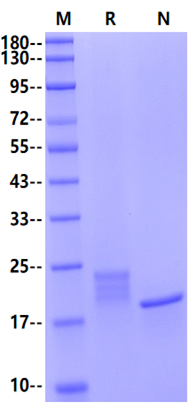 全部商品分类
全部商品分类
Cys24-Asp189, with C-terminal 8*His CDLPQTHSLGNRRALILLAQMGRISHFSCLKDRHDFGFPEEEFDGHQFQKAQAISVLHEMIQQTFNLFSTEDSSAAWEQSLLEKFSTELYQQLNDLEACVIQEVGVEETPLMNEDSILAVRKYFQRITLYLTEKKYSPCAWEVVRAEIMRSLSFSTNLQKRLRRKDGGGSHHHHHHHH

17-25kDa








1μg (R: reducing condition, N: non-reducing condition).
"}]

The interferons (IFN) are a family of cytokines with potent antiviral, antiproliferative and immunomodulatory properties, and are classified based on their binding specificity to cell surface receptors. The type I IFNs bind to the interferon alpha receptor (IFNAR), which consists of two subunits: IFNAR1 (alpha-subunit) and IFNAR2 (beta-subunit). This binding contributes to TNF-alpha induced signaling. IFN-α/β and related molecules are classified as type I IFNs, as for the other two types of type II IFN (IFN-γ) and type III IFNs (IFN-λ), respectively. Interferon alpha (IFNa) shows significant biological activity in various cancers, particularly haematological malignancies such as hairy cell leukaemia and chronic myelogenous leukaemia. IFN-alpha 4 is promoted by interferon (IFN) regulatory factors (IRFs), especially IRF-1 and IRF-7. And it exhibits function by inhibiting virus RNA replication and enhances human natural killer cytotoxicity against virus.

Reconstitute at 0.1-1 mg/ml according to the size in ultrapure water after rapid centrifugation.

· 12 months from date of receipt, lyophilized powder stored at -20 to -80℃.
· 3 months, -20 to -80℃ under sterile conditions after reconstitution.
· 1 week, 2 to 8℃ under sterile conditions after reconstitution.
· Please avoid repeated freeze-thaw cycles.
1. Pestka S, et al. (1987) Annu Rev Biochem. 56:727.
2. Fung, K.Y. et al. (2013) Science 339:1088.
3. Matsumiya, T. et al. (2007) J. Immunol. 179:4542.
4. Raj NB, et al. Identification of a novel virus-responsive sequence in the promoter of murine interferon-alpha genes. J Biol Chem. 1991 Jun 15, 266(17):11360-5.

参考图片
1μg (R: reducing condition, N: non-reducing condition).







 用小程序,查商品更便捷
用小程序,查商品更便捷




